Salad Ideas Your Picky Eater Will Love
Discover effective tips and tricks to make salads appealing for your little picky eater! Learn how to create fun salad bars, incorporate diverse, yummy ingredients, and foster a positive relationship with food.
Updated July 29, 2024

When it comes to finding meal options packed with fruits, veggies, and essential nutrients, salads are hard to beat. They're endlessly customizable, easy to whip up on the fly and combine a variety of different foods in one scrumptious dish.
Sadly, for many parents, the idea of preparing a salad for kids that will actually end up in their tummies (and not on the floor) can seem unrealistic and overwhelming. But don't worry: It is possible to create healthy and delicious salads for picky eaters, and we're going to show you how.
» Explore yummy plant-powered nutrition for healthy growth
What does 'picky eating' really mean?
Because kids can be selective about food in many different ways, the concept of picky eating doesn't have a set definition. But the term is generally used to describe eaters who reject certain foods outright, eat a very limited variety of foods, or often change their food preferences because of things like sensory sensitivities and the way food is presented.
Your toddler might not like the way a particular food looks, smells, tastes, or feels in their mouth, or they might be afraid to try something they've never had before. These kinds of preferences can be a natural phase of development and aren't always a cause for concern.
» Try these yummy smoothies for picky eaters
Many children grow out of these tendencies by the time they're about 3 or 4 years old, but picky eating can sometimes last into adulthood and does have the potential to impact long-term health.
Since a lot of picky eaters prefer lower-nutrient, processed foods, their aversions can cause deficiencies in certain micronutrients, such as iron, zinc, selenium, and beta-carotene. What's more, picky eating can turn mealtime into a stressful and frustrating experience for kids and parents alike rather than an opportunity for quality family time.
» Be sure to include these essential nutrients in your little one's diet
Addressing picky eating in kids
Addressing picky eating might seem daunting, but scientists are working on solutions. A 2018 study published in the scientific journal Appetite found that introducing "lumpy" foods into your infant's diet between six and nine months of age can help reduce the likelihood of picky eating as they grow.
There's even evidence that a mother's diet while pregnant and breastfeeding could help prevent picky eating by exposing babies to a wider range of flavors and textures early on.
» Discover yummy high-fiber foods even picky eaters will love
According to the research, offering fresh options such as fruit in infancy is also vital to helping your child learn to enjoy a variety of foods. And here's a key element: pressure from parents to eat certain foods can actually make picky eating behaviors worse—meaning it's important to focus on consistently offering healthy options rather than forcing a rigid menu.
So, how can you use these insights to make salad a staple of your toddler's diet—especially if they are already picky eaters?
» Explore top nutritious snacks for 10-month-olds
Making salads fun for picky eaters: Tips & tricks for stress-free mealtime
1. Make a salad bar
Like most of us, kids prefer to have options. And what better way to give them choices and make mealtime more interactive than by setting up your own salad bar? Stock your salad bar with a variety of greens, proteins, and other toppings for your toddler to choose from.
» Understand the benefits of a whole-food diet for kids
Keep the greens simple
For the base of your salad, go for something simple like baby spinach, tomato, or cucumber, making sure to chop the leaves into small, easy-to-eat pieces.
Add protein
If your family eats meat, shredded chicken or salmon is a great source of protein, but you can also opt for beans, chickpeas, eggs, or even finely crushed nuts.
Be aware of choking hazards (children shouldn't eat whole nuts until they're at least 4 to 6 years old) by making sure each ingredient is cut up small enough for them to chew.
» Learn more about food groups for kids
Add texture
For added flavor and texture, consider fresh or dried fruit, like raisins or craisins, cheese (or non-dairy cheese) crumbles, or cooked grains, such as quinoa, couscous, and rice.
Don't forget the dressing
Finish off your kid-friendly salad bar with a light coating or side portion of dressing, such as a traditional Caesar, a zingy orange, or a creamy Dijon. Then all that's left to do is set all the fixings out in a mini assembly line and encourage your little tyke to choose three or four ingredients for their salad.
» Here's all you need to know about healthy foods for toddlers
2. Get creative with serving
You can make the spread even more inviting by using a variety of vibrant bowls, crafting fun little name cards for each offering, or even using the salad bar as a visual aid to help your little one practice their counting or colors. The best part is that your toddler will get to go through the line alongside their parents or siblings, just like in a real-life restaurant.
They may not make a beeline for the "healthiest" toppings, but that's okay—the important thing is that your child is creating a positive relationship with salad. Their taste for nutrient-rich foods such as dark leafy greens may not come until later, but it will likely never develop if your picky eater believes they categorically dislike all salad.
» Discover more ideas for side dishes for picky eaters
3. Repeated exposure is key
Researchers have found that repeated exposure to unfamiliar foods may help improve picky eating, and in some cases, kids may need to try a food 10 to 15 times before they become comfortable with it. That's why it's important to continue offering a variety of fresh foods to your child without forcing anything on them.
The more you make salad bars a part of your regular mealtime routine, the more opportunities your picky eater will have to be exposed to these nutritious options.
Providing options doesn't mean, however, that you should always be preparing a special meal just for your picky eater. Research has demonstrated that it's helpful for parents to eat the same meal as their toddler whenever possible, so try making salad night a family affair.
4. Model positive eating habits
This is also a chance for you to model positive eating habits, as seeing you or your older siblings enjoying a diverse range of foods will only improve the odds that your toddler will accept these foods over time. The beauty of the salad bar is that your child's salad doesn't need to look exactly like yours, but you're still sharing the mealtime experience.
» Try these delicious, healthy, and kid-approved foods for picky eaters
5. Be patient!
Focus on positive encouragement rather than punishment when it comes to your toddler trying new foods, and avoid coercive tactics such as offering "rewards" for eating certain things. The goal is to make your child feel safe to try—and potentially dislike—a wide variety of foods without the fear of pressure or judgment.
» Explore our extensive guide to healthy foods and nutrition for toddlers
What if my toddler doesn't like lettuce?
If your kiddo isn't so keen on greens, experiment with other types of salads that incorporate essential nutrients and vegetables.
Try taco salads!
Taco salads, for example, can be filled to the brim with high-fiber, healthy ingredients, such as black or pinto beans, diced avocado, tomato, sweet corn, and even roasted carrots or sweet potatoes. You can top your taco salad with a bit of shredded lettuce (or add some on the side) to encourage your toddler to start getting used to the flavor and texture. But even if the lettuce is ultimately left on the plate, you can be confident that your child has had a nutritious meal.
» Here's how to support your kiddo's natural immunity with nutrition
Experiment with pasta salad
Many parents also turn to pasta salad for picky eaters because, well, who doesn't love a good noodle? Depending on your toddler's preferences, you can dress your pasta salad up with all kinds of toppings, such as shredded chicken, olives, peas, peppers, diced cucumber, red onion, and hard-boiled egg—the possibilities are limitless.
To pack an even bigger nutritional punch, consider opting for chickpea or lentil pasta. These are high in protein and fiber and gluten-free. Another potential alternative is spiralized vegetables, such as zucchini or carrot "noodles," provided they're chopped small enough to avoid choking.
There's lots of room to experiment with the dressing, as well, from a simple mixture of olive oil and spices to a more traditional vinaigrette.
» Try this creamy marinara with hidden veggies
Opt for a fruit salad
When in doubt, fruit salads are always an option, too. (Remember the study that showed feeding kids fresh fruit can help them become less picky?) Because of the natural sweetness of fruits, this type of salad can be a great idea for dessert, but you can also opt for a fruit salsa that pairs well with chips and other savory snacks.
Simply pick a few of your toddler's favorites, such as mangoes, grapes, berries, apples, kiwis, peaches, or pears, and chop them into bite-sized bits. Then, combine it with a sauce or dressing such as fresh citrus juice, honey, Greek yogurt, or your favorite non-dairy alternative.
» Discover more healthy recipes for picky eaters
My picky eater doesn't like dressing. How can I get them to eat salad?
Picky eating can stem from a range of dislikes, whether it be the taste, look, or texture of the food that puts your toddler off. Unsurprisingly, some kids simply can't stand the sogginess of a salad that's been sitting in dressing for a bit too long.
One option is to try a deconstructed salad by separating out the ingredients on your child's plate. This helps them know exactly what they're eating and allows your toddler to take what they like and leave what they don't (without the whole meal going out the window because the carrots are touching the broccoli). Plus, the smaller, separated bits are easier for little hands to pick up!
» Explore the ultimate picky eater's food list for stress-free meals
You can pair this with a couple of different dip choices, such as a Greek yogurt-based or non-dairy Ranch dressing or even nut butter. Your kiddo might avoid the dip altogether, but they may also find that they like a bit of dressing as long as the salad isn't swimming in it.
Work on being flexible and attentive to your child's needs. If they speak up about something they don't like, be sure to listen to their reasoning. This can help you make adjustments that may make your child more open to trying new meals. Part of the key to success when it comes to making a salad for kids is letting go of rigid expectations and the urge to force specific foods.
» Understand how to plan your toddler's meals
What if my picky eater still won't eat salad?
If you're concerned that your child's diet is missing key nutrients, consider speaking with your pediatrician or visiting a nutritionist to discuss their dietary needs.
Picky eaters can also sometimes benefit from nutrient-dense solutions such as Else, a unique nutritional beverage with protein sourced from almonds, tapioca, and buckwheat. Free of dairy, soy, and gluten, Else is a plant-based, non-GMO alternative to traditional nutrition supplements for toddlers. It's also high in fiber, low in sugar, and packed with vitamins and minerals your child's diet may be lacking.
» Read why almonds are so beneficial
While picky eating can sometimes feel like an insurmountable challenge, there are strategies and solutions to ensure your child is getting the nutrients they need while also developing a healthy relationship with food. We're here to help — whether salad is on the menu or not.
» Explore the delicious world of plant-based nutrition for a healthier start
The content and advice provided in this article are for informational purposes only and are not a substitute for medical diagnosis, treatment, or advice for specific medical conditions. Always consult a pediatrician to understand the individual needs of your child.











